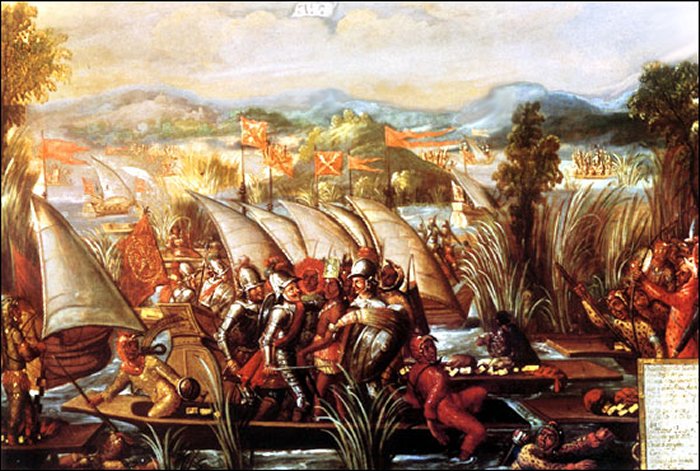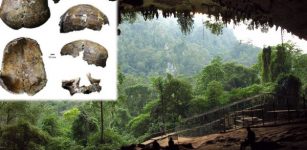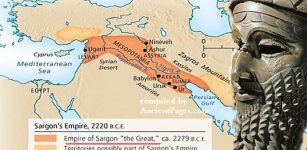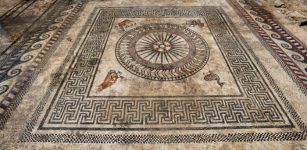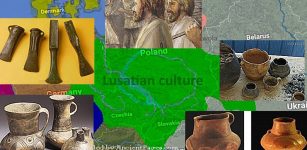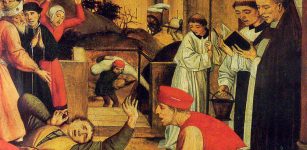Huge Golden Eagle Relief Made By The Aztecs Discovered At Tenochtitlan
Jan Bartek – AncientPages.com – A magnificent, huge golden eagle bas relief has been discovered at Tenochtitlan, the ancient capital of the Aztec Empire.
On November 8, 1519, Hernán Cortés, a Spanish Conquistador entered Tenochtitlán, the capital of the Aztec Empire.
Cortés led an expedition that contributed much to the fall of the Aztec Empire. During the march through Mexico, Cortés encountered a group of natives called the Tlaxcalans, who were enemies of the Aztecs. They became an important ally for Cortés during his siege of Tenochtitlán, the Aztec capital city.
The capture of Cuauhtémoc. 17th century, oil on canvas. Credit: Public Domain
The Aztecs tried to defend their city, but despite their courageous efforts, the Spanish forces ended with the victory.
On February 28, 1525, Cuauhtémoc, the last ruler of the Aztecs, was executed by the conquistadors of Hernán Cortés.
Today, we can marvel at the ancient artifacts, buildings, and reliefs left by this one powerful civilization.
Templo Mayor Was Dedicated To Aztec Gods Tlaloc And Huitzilopochtli
The Golden Eagle bas-relief recently uncovered by Templo Mayor Project (PTM) is a truly impressive legacy of the ancient Aztec world. With 3.47’ (1.06 m) long and 27.55’’ (70 cm) wide, it is the biggest relief among similar stone carvings found thus far.
The piece was spotted at the base of Templo Mayor, on the central axis of a “chapel” dedicated to Huitzilopochtli. It might correspond to the years of Motecuhzoma Ilhuicamina’s reign (1440-1469 A. D.).
Templo Mayor was a sacred Aztec complex dedicated to gods Tlaloc and Huitzilopochtli who were usually appeased with human sacrifices.
According to scholars, the golden eagle carving’s relevance is evident not only for its size and decoration but for its location at the base of the most important building in the Aztec world.
Golden Eagle carving recently uncovered by Templo Mayor Project (PTM). Credit: Mirsa Islas
It was uncovered at the central axis that traverses the “chapel” of Huitzilopochtli and the monumental sculpture of goddess Coyolxauhqui. The piece is also close to the Cuauhxicalco, a circular structure whose name means “Place of the Eagle’s Cup” and where sixteenth-century documents indicate that Aztec rulers were cremated.
The plaza’s floor was covered since the Pre-Columbian era during Templo Mayor’s expansions. “That is why is it so well preserved,” scientists said. “It is an element that was never seen by the Spaniards.”
“This floor is unique among the whole Templo Mayor complex, as it contains bas-reliefs that symbolize the site’s dual nature. On the south side, where we are currently exploring, elements such as this raptor are linked with Huitzilopochtli’s mythical life cycle.
In contrast, the bas-reliefs located at the northern section —the former ones uncovered in 1900 by Leopoldo Batres, and the latter ones by the PTM and Mexico City’s Urban Archaeology Programme (PAU)— depict representations associated with Tlaloc, the water cycle, and regeneration of maize,” chief archaeologist Leonardo López Luján said.
The Golden Eagle Symbolism
“For what we have seen in pictures, it is a beautifully made piece that shows the great mysteries that former Mexico Tenochtitlan’s Templo Mayor still has to reveal. I would like to acknowledge the INAH archaeologists who collaborate in this site.
It is because of their effort and dedication that we can continue to recover our history and our memory of the past. Fieldwork has been postponed due to the health emergency, but it is clear that there is a thriving research and an academic reflection that has not been stopped,” Mexican Cultural Minister, Alejandra Frausto Guerrero said about this outstanding finding.
Eagle and Jaguar Warriors as depicted in the Florentine Codex Book – Read more
The COVID-19 delays enabled PTM’s researchers to study several elements from the structure, including the bas-relief. Among other aspects, they analyzed the available iconography in ancient sources such as codices so they can correlate them with this piece.
According to PTM’s archaeologist Rodolfo Aguilar Tapia one of these representations is found in Codex Borgia’s page 50, where a golden eagle stands on a mesquite —a tree that was believed to grow from a flayed skin deity.
See also: More Archaeology News
“What interests us is that in terms of iconography, this image is very similar to the bas-relief found on fieldwork. Both representations have knifelike feathers that emulate the ones used on ritual sacrifices. This reminds us of the Nahua name of the raptor: Obsidian Eagle.”
For the Aztecs, the bird of prey had a close relationship with war and sacrifice. It was also considered as the Sun’s nahual or shape-shifting spirit, and therefore as Huitzilopochtli’s protective deity.
Written by Jan Bartek – MessageToEagle.com – AncientPages.com Staff Writer

